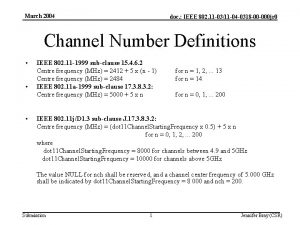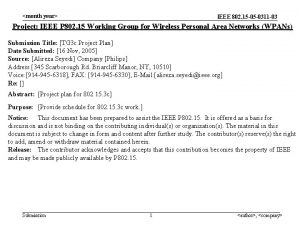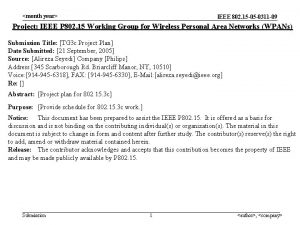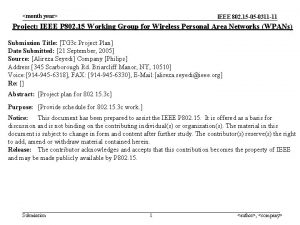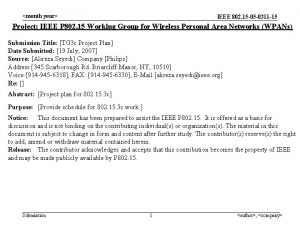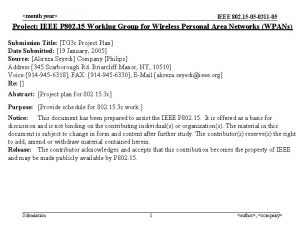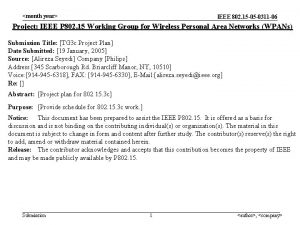May 2010 doc IEEE 802 15 10 0311










- Slides: 10

May 2010 doc. : IEEE 802. 15 -10 -0311 -00 -004 g Project: IEEE P 802. 15 Working Group for Wireless Personal Area Networks (WPANs) Submission Title: [Comments on multi-PHY mode in 802. 15. 4 g] Date Submitted: [18 May 2010] Source: [Yang, Xiang Wang, Heqing Huang, Jie Shen, Tao Xin, Haitao Liu, Liang Li] Company [SIMIT] Address [865 Changning Rd. Shanghai, China] Voice: [+86 -21 -62511070 -5256], E-Mail: [youcyyang@gmail. com] Abstract: [This document provides some comments on the multi-PHY mode in 802. 15. 4 g. ] Purpose: [This document intends to gather some comments on the multi-PHY mode in 802. 15. 4 g, to help discussion about CSM more convenient. ] Notice: This document has been prepared to assist the IEEE P 802. 15. It is offered as a basis for discussion and is not binding on the contributing individual(s) or organization(s). The material in this document is subject to change in form and content after further study. The contributor(s) reserve(s) the right to add, amend or withdraw material contained herein. Release: The contributor acknowledges and accepts that this contribution becomes the property of IEEE and may be made publicly available by P 802. 15. TG 4 g Presentation Slide 1 Chin-Sean Sum

May 2010 doc. : IEEE 802. 15 -10 -0311 -00 -004 g Summary • Motivation – Multi-PHY mode have some problems needed to be discuss • Objective – Provide existing multi-PHY mode mechanism in 4 g – Analyze different potential problems for multi-PHY mode operation – Conclude these comments in one Power. Point to help us discuss them more conveniently TG 4 g Presentation Slide 2 Youcy Yang, SIMIT

May 2010 doc. : IEEE 802. 15 -10 -0311 -00 -004 g Existing Multi-PHY Mode in 802. 15. 4 g • Coordinators – Send coex-beacon frames in the common signaling mode (CSM) periodically • Potential coordinators – Before starting respective networks in a channel, scan coex-beacon frames in CSM – Upon receiving coex-beacon, change channel or achieve synchronization with the existing network • Devices – Unassociated device advertise Request To Join command in CSM – Associated device send Request To Join Reply command in CSM – Unassociated device use PHY mode defined in RTJR to perform standard association process TG 4 g Presentation Slide 3 Youcy Yang, SIMIT

May 2010 doc. : IEEE 802. 15 -10 -0311 -00 -004 g Channel Definition of CSM • Common Signaling Mode • Each band has several channels, then for each band – if the CSM will be just on one certain channel? – or will operate on every channel? TG 4 g Presentation Slide 4 Youcy Yang, SIMIT

May 2010 doc. : IEEE 802. 15 -10 -0311 -00 -004 g Starting a New PAN • On receipt of coex-beacon frame in CSM – Change channel differ from the PHY mode informed in coexbeacon frame – can’t get information of the channel having been used just by the PHY mode, as each PHY mode will have several channels – and still have chance to conflict, as in the EGTS channel hopping mode, or TSCH mode, different slots will operate on different channels – Suggestion – Inform the usage situation of channels in coex-beacon frame, if we support channel hopping mode, maybe should include an ABT in coex-beacon frame TG 4 g Presentation Slide 5 Youcy Yang, SIMIT

May 2010 doc. : IEEE 802. 15 -10 -0311 -00 -004 g Starting a New PAN • On receipt of coex-beacon frame in CSM – achieve synchronization with the existing network – Don’t have timing information applicable for synchronization in existing coex-beacon frame format – “while specific mechanisms to achieve synchronization between two PANs utilizing different PHY modes are implementation-dependent”? – When to start superframe schedule of the incoming coordinator? TG 4 g Presentation Slide 6 Youcy Yang, SIMIT

May 2010 doc. : IEEE 802. 15 -10 -0311 -00 -004 g Low Energy Discovery Mechanism • Unassociated device will use PHY mode defined in RTJR received to perform standard association process – the PHY mode used by the PAN of the associated device which received RTJ – for the standard association process, device will send association request command to coordinator, address of which will be get from beacon frame • The unassociated device may be out of the communication range of the PAN coordinator TG 4 g Presentation Slide 7 Youcy Yang, SIMIT

May 2010 doc. : IEEE 802. 15 -10 -0311 -00 -004 g Another Problem Caused by Multi-PHY Mode • Different PHY mode has different symbol rate, then the length of superframe which is defined by the symbol duration will be different – If just define PHY mode in coex-beacon frame, like MR-OQPSK, can’t get the symbol rate, and then can’t get the length of the superframe TG 4 g Presentation Slide 8 Youcy Yang, SIMIT

May 2010 doc. : IEEE 802. 15 -10 -0311 -00 -004 g Conclusion • This document presents the overview on the existing multi -PHY mode in 802. 15. 4 g • This document provides some comments about the multi. PHY mode in 802. 15. 4 g • A substantial amount of work of multi-PHY mode is still needed for multi-PHY mode in 802. 15. 4 g TG 4 g Presentation Slide 9 Chin-Sean Sum

May 2010 doc. : IEEE 802. 15 -10 -0311 -00 -004 g Thank you! TG 4 g Presentation Slide 10 Youcy Yang, SIMIT











